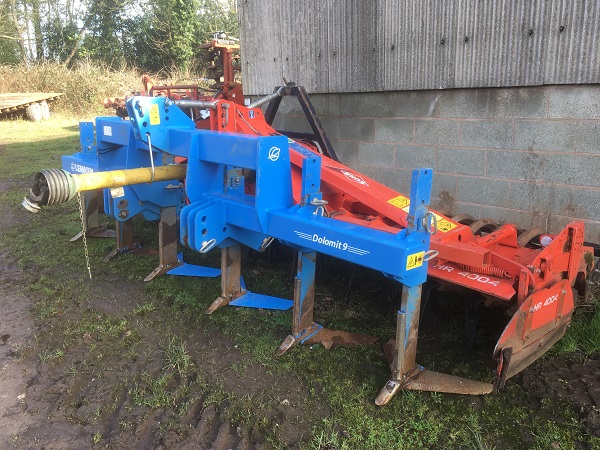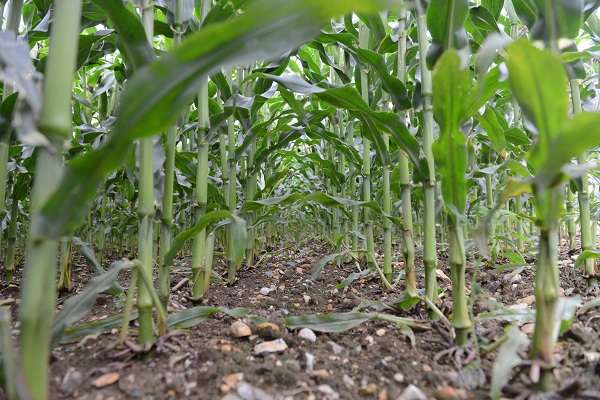Weed competition for light, moisture and nutrients can seriously reduce the maize crop’s yield potential from the outset. CPM finds out how to get the crop up and away.
Get the seedbed right, then that’s the start to producing big yields of maize.
By Lucy de la Pasture
When Ian Grandfield says the power harrow should be banned from anywhere near maize seedbeds, he’s deadly serious. Director of forage specialists, Green Gem Agriculture, his thirty-years agronomy experience in maize means he has good reason for his opinion on the familiar bit of tackle. And it’s simple, power harrows don’t create good seedbeds.
“Adapt it with a cultivator on the front, if you must use one, but min til equipment like Discaerator cultivators or Simbas are preferable when it comes to creating the right seedbed conditions for maize,” he says.
“The aim is a depth of seed bed so when you walk on it, you sink in, But it’s also important to have some lumps in there of at least 2-5mm and not the fine tilth a power harrow produces,” he says.

Power harrows don’t create good maize seedbeds but can be adapted as shown in the above photo.
His reasoning is that the larger aggregates provides a structure that won’t slump if there’s heavy rain. The air gets into the soil more easily and it creates a warmer seedbed, with the finer tilth underneath. Power harrows often produce seedbeds with a compacted layer underneath. With maize being a notoriously shy rooter, that means the crop begins to struggle at the time when it needs to be flying.
“It’s not a cloddy seedbed you’re aiming for but a deep, fluffy one,” he clarifies. “If you get the seedbed right, then that’s the start to producing big yields of maize.”
In maize, once the crop is out of the ground, competition is the next big factor influencing yield. The most competitive maize plant is the plant next door so making sure ground conditions are right so that plants are of an even size will minimise the effects of shading and competition for nutrients.
There’s a critical period 4-6 weeks after drilling, 10-30 days post emergence of the crop, when the maize needs to be kept weed free. With many of the maize herbicide products coming from the Syngenta stable, field technical manager, Steve Bull gives his advice.
“Weed competition leads to pale, weak-stemmed and shallow-rooted plants, more susceptible to stress conditions through the growing season and more liable to lodging. Early removal of weed competition encourages strong healthy plants that are better able to maximise the use of sunlight and optimize the use of other inputs.

Competition for water, nutrients and light will limit maize yields so good weed control is important.
“Weed competition has been shown to result in inconsistent cob size and fewer kernals – resulting in lower yields and reduced silage energy quality – be that for animal feed or energy production.”
Steve Bull advocates all weeds should be removed at the earliest opportunity, ideally before they reach 10cm high and before the crop is at the four-leaf stage. Whatever the season, the pre-emergence herbicide Dual Gold (s-metolachlor) can help ensure a clean seedbed for crop emergence, and buys valuable flexibility in timing for following post-emergence clean-up, he reckons.
“Maize weed control demands a long window of herbicide application and variable target zone for sprays, from bare soil to heavy weed infestations. The Syngenta 3D Nozzle has proven highly effective in delivering better results.”
For optimum pre-emergence application, the angled nozzles should be alternated to face forwards and backwards along the spray boom to help give better coverage, especially with cloddy soils.
“Growers should aim for a fine seedbed to help achieve precision sowing at a consistent depth, for even emergence. But in difficult spring conditions, or soils where slumping can be a risk, seedbeds may be more cloddy than desired. Using angled nozzles for pre-emergence applications can help.”
Where pre-emergence applications have to be made but spraying conditions are sub-optimal, he urges operators to aim for ‘low and slow’ to minimise the risk of drift – a problem which reduces the amount of product hitting the target, with potential consequences on herbicide efficacy.
“Aim for a forward speed of 12km/h, or less, with the boom height at a maximum 50cm above the soil target. Spray pressures can be reduced to ensure nozzles are operating at drift-reduction ratings. Operators should also consider using coarse or low-drift nozzles if spray drift is a risk,” he suggests.
As the maize plants increase in size for post-emergence applications, Steve Bull points out that the amount of herbicide spray intercepted by the crop also increases. That can significantly affect the amount of herbicide reaching the target weeds – which are also larger and more difficult to control.
“Again the angled nozzle, alternated to face forwards and backwards, delivers better spray penetration of the canopy to reach the weeds,” he advises.
An increase in both crop and weed size also has an important implication for product choice, warns Steve Bull.
“More effective options and mixes, including Calaris (mesotrione+ terbuthylazine) and Callisto (mesotrione), are important in achieving high levels of control and being crop safe on the establishing maize plants.”
Dorset sprayer operator and former FSOOTY winner, Iain Robertson, advocates the use of Syngenta 3D Nozzles for all maize herbicide applications, wherever conditions allow. He firmly believes that slowing down to the optimum forward speed and keeping the correctly set boom steady is crucial to get the best performance from pre and post-em applications.
“Pre-emergence treatments give valuable flexibility for our targeted post-em applications, based on Calaris or Calaris-mix programmes” he adds.
Herbicide addition to maize armoury
A new maize herbicide is available for this season from Syngenta. The product will add extra flexibility in removing damaging competition to emerging crops through the crucial early days of establishment, claims Steve Bull.
Camix (s-metolachlor+ mesotrione) is a combination of well proven active substances which can be safely applied as the crop is establishing, he says, to remove early competition, and gives long-lasting residual activity against a broad spectrum of weeds.
Steve Bull highlights that growers can aim for treatment timing so that the crop grows away in clean, weed-free conditions.
“If application is delayed by weather or logistics, or if some or all the crop emerges faster than anticipated, Camix can still be used to knock out existing weeds and give outstanding residual control as the maize crop establishes.”
He believes the option will be especially popular with maize contractors, where busy workloads across a wide area can make herbicide application scheduling more difficult.
Stress from weed competition through the early stages of maize establishment will quickly limit development. It can result in a maize plant canopy structure that will seriously reduce growth throughout the season, with knock-on effects on overall yields of leaf and cob, he points out.
“It’s particularly useful in control of annual grass-weeds, which is important for the crop but also increases the value of maize as a break in the arable rotation. In combination with mesotrione, there’s also the excellent coverage of a wide spectrum of competitive broad-leaf weeds found commonly in maize fields.”
Agronomists can recommend one application of Camix per crop at a rate of 1.8 l/ha up to the four-leaf unfurled growth stage of the maize, with early post-emergence proven to be the optimum timing.
Camix may be used in combination with Dual Gold pre-emergence and/or in sequence with Calaris or Calisto post-emergence, to enhance the spectrum and duration of weed control, subject to permitted levels of overall active application, he emphasizes.
A boost for maize
Liquid carbon-based fertiliser can help get maize crops quickly up and away, claims David Maxwell of QLF Agronomy.
So what’s different about carbon-based fertilisers? In a nutshell, they don’t just feed the plant, they feed the soil, he explains.
“Our liquid product Boost is rich in carbon which provides energy to beneficial soil bacteria, which enhances plant nutrient availability to help improve plant performance, root growth, yields and crop quality.
“In essence it supercharges the soil to improve nutrient flow, which is important to achieve the best crop potential. A first application is recommended at planting with subsequent application at post-emergence to keep the soil ‘charged’ through other key growing phases,” he explains.
As with all products, the proof is of the pudding is in the eating, and maize growers have noted visible differences in growth of both foliage and roots where Boost has been applied. But anecdotal evidence isn’t enough, believes David Maxwell.
“Many trials have been conducted on Boost in the US which have shown excellent results and Gary Zimmer, founder of Midwestern BioAg and often seen as the pioneer of ‘biological farming’ recommends the use of Boost and is a strong advocate of its benefits. But QLF Agronomy also wanted data from local UK trials,” he explains.
So with the aim of gathering more local scientific evidence, Harper Adams University’s (HAU) Crop Environment Research Centre, in conjunction with Maize Growers Association, conducted replicated trials on the product in 2016 on maize. Further trails were undertaken by HAU on potatoes.
“In maize the trials showed yield gains of up to 11%, compared with the control treatment. There was also an increase in starch and M.E. in the treated crop. There are plans to extend the programme this year to other crops,” he adds.
With standard applications of approximately 20 l/ha, costing in the region of £13/ha, only a modest yield increase of 2% (crop dependant) will pay for the application, he points out.




